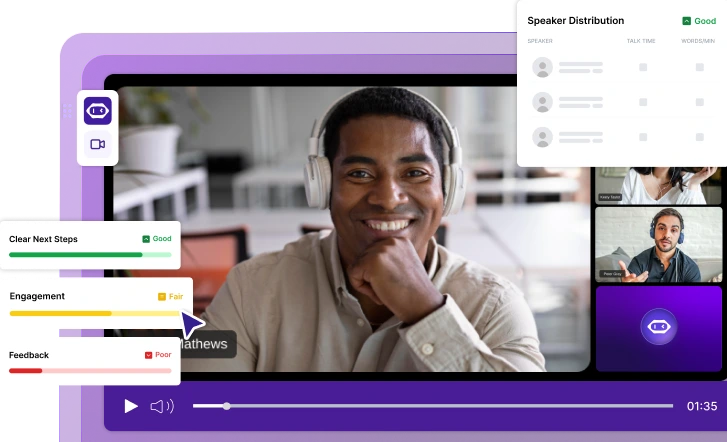Modelo gratuito de ata de reunião de diretoria e melhores práticas
Use esses modelos gratuitos para atas de reuniões do conselho e descubra as melhores práticas para capturar e organizar discussões importantes de forma eficaz.

✅ Free meeting recording & transcription
💬 Automated sharing of insights to other tools.

Fonte da imagem: pch.vector em Freepik
Você está procurando uma maneira de manter suas reuniões de diretoria organizadas e eficientes? Não procure mais!
Neste artigo, fornecemos modelos gratuitos de atas de reuniões do conselho, juntamente com as melhores práticas para garantir que você capture todas as informações essenciais. Seja você um profissional experiente ou novato nessa tarefa, estamos aqui para ajudá-lo a agilizar o processo e melhorar a eficácia de suas reuniões.
Vamos mergulhar e encontrar para você o modelo perfeito de ata de reunião de diretoria!
O que são atas de reuniões do conselho?
As atas das reuniões do conselho são um registro oficial do que acontece durante uma reunião do conselho. Eles documentam as discussões, decisões e ações que ocorrem, fornecendo um relato factual e detalhado da reunião.
Esses atas da reunião servem a vários propósitos importantes: garantem transparência, ajudam na prestação de contas e oferecem um registro histórico que pode ser consultado para esclarecimentos ou por motivos legais.
O que as atas das reuniões do conselho devem incluir?
As notas das reuniões do conselho capturam a essência de suas reuniões executivas, então você precisa garantir que elas sejam claras, concisas e incluam apenas informações relevantes para permanecerem úteis e eficazes.

Veja o que você deve incluir nas atas das reuniões do conselho:
- Data e hora: Sempre anote a data e a hora da reunião para organizar os registros ao longo do tempo e verificar se as reuniões ocorreram conforme programado.
- Tipo de reunião: especifique se a reunião é uma sessão regular, especial ou de emergência para contextualizar as decisões tomadas.
- Participantes e ausência: Liste todos os membros presentes e anote as ausências para determinar se a reunião atingiu o quórum e se as decisões tomadas são válidas.
- Hóspedes: registre os nomes de todos os não membros que participaram e sua função durante a reunião. Isso pode incluir especialistas, parceiros em potencial ou palestrantes especiais.
- Relatórios: Resuma os principais pontos dos relatórios apresentados durante a reunião, como relatórios financeiros, relatórios de comitês ou relatórios executivos. Inclua quaisquer dados ou conclusões críticas compartilhadas.
- Resoluções: Essas são decisões importantes que afetam a direção da organização. Detalhe todas as resoluções propostas e votadas, incluindo o resultado de cada votação.
- Ações: Documento itens de ação estabelecido durante a reunião, incluindo quem é responsável por cada tarefa e quaisquer prazos aplicáveis.
- Informações ou instruções adicionais: Às vezes, notas ou instruções adicionais que não se encaixam na pauta da reunião do conselho aparecem durante a reunião. Dependendo da importância deles, talvez seja necessário anotá-los.
Aqui estão algumas coisas opcionais que você pode incluir nas atas das reuniões do conselho:
- Notificação formal: Indique se todas as notificações antecipadas necessárias foram enviadas de acordo com o estatuto para confirmar a legalidade da reunião.
- Quórum: Confirme se o número de membros presentes atende ao requisito de quórum, conforme definido no estatuto, para prosseguir com a tomada de decisões oficiais.
- Partidas e entradas: Anote todos os membros que chegam atrasados ou saem mais cedo. Isso pode afetar o quórum e os resultados da votação e é importante para a precisão das atas.
Modelos de atas de reuniões do conselho
Reunimos 6 modelos de exemplo diferentes que você pode personalizar de acordo com suas preferências. Confira abaixo!
A. Modelo de ata de reunião do conselho da MeetGeek
Se você estiver interessado em como gravar atas de uma reunião do conselho, o MeetGeek tem a solução perfeita para você.
Oferecemos modelos prontos que você pode personalizar ainda mais de acordo com suas necessidades e nosso assistente virtual de IA participará das reuniões do conselho e atualizará automaticamente os campos em branco com as informações compartilhadas durante a conversa.
Dessa forma, você obtém notas de reunião personalizadas de acordo com seus requisitos exclusivos, economizando tempo e esforço.
Aqui está o que nosso modelo de ata de reunião do conselho parece que no começo:
NOTA: Nosso modelo de reunião virtual do conselho apresenta:
- Uma agenda pré-preenchida e editável que você pode personalizar para atender às suas necessidades.
- Destaques (tags) para ajudar você a identificar rapidamente os principais tópicos, como #compliance, #decision, #financial_health_status, #action_items e #strategic_direction.
- KPIs de reuniões que rastreiam métricas importantes, incluindo taxa de implementação de decisões, precisão de relatórios financeiros, adesão à agenda de reuniões, taxa de participação de membros, progresso da iniciativa estratégica, taxa de tempo de conversação, sentimento de chamada e muito mais. Esses KPIs oferecem uma visão geral da sua reunião e ajudam a melhorar a eficácia das futuras.
B. Modelo simples de ata de reunião do conselho
C. Modelo de ata de reunião formal/de diretores
D. Modelo de reunião do conselho de funcionários
E. Modelo de ata de reunião mensal executiva
F. Modelo de ata de reunião do conselho de emergência
Atas da reunião do conselho: DO's
Ao lidar com as atas das reuniões do conselho, você deve garantir que elas não sejam apenas precisas e completas, mas também sirvam como uma ferramenta eficaz de governança e responsabilidade.
Aqui estão as ações mais importantes das atas das reuniões do conselho:
- Use a pauta da reunião como modelo
- Designe uma pessoa que toma minutos
- Use a IA para gravar e transcrever sua reunião do conselho
- Defina expectativas para as atas das reuniões do conselho
- Adote um tom objetivo
- Inclua todos os detalhes relevantes
- Revise e compartilhe os minutos
- Siga os requisitos legais
1. Use sua agenda de reuniões como modelo
Começando seus minutos com o agenda da reunião como modelo é uma abordagem eficiente e organizada. A pauta normalmente inclui todos os tópicos que serão abordados durante a reunião, portanto, usá-la como modelo garante que suas atas sejam abrangentes e estruturadas de forma lógica.
Esse método ajuda o tomador de notas a acompanhar as discussões e decisões em relação aos itens planejados da agenda, garantindo que os membros do conselho e os participantes ausentes não percam nada importante.
2. Atribua uma pessoa que toma minutos
Falando em anotadores, designar uma pessoa específica para tomar minutos é crucial para criar registros de reuniões precisos e consistentes.
Quem toma minutos deve ser alguém que tenha boas habilidades de escuta e digitação, esteja familiarizado com os participantes da reunião e compreenda os tópicos discutidos.
Normalmente, o secretário do conselho é responsável por essa tarefa. No entanto, em momentos de necessidade, essa função pode ser alternada entre os funcionários para compartilhar responsabilidades e dar a todos uma compreensão do processo, o que pode aumentar o envolvimento e a conscientização geral da equipe.

3. Use a IA para gravar e transcrever sua reunião de diretoria
Ferramentas modernas de IA, como Conheça o Geek pode gravar suas reuniões e transcrever automaticamente as conversas em texto, que todos podem ainda chamar de documentação de toda a discussão e principais destaques.
Isso não só economiza tempo, mas também reduz os erros na captura do que foi discutido,

Veja como o MeetGeek pode transformar suas reuniões de diretoria em um modelo de eficiência e colaboração:
- Gravação e transcrição de reuniões: Com o MeetGeek, cada reunião do conselho é gravada e transcrita automaticamente. Isso é especialmente útil para membros do conselho que não podem comparecer em tempo real, pois permite que eles revisem as discussões conforme sua conveniência e fiquem em sintonia com as decisões e a direção estratégica do conselho.
- Detecção de pontos-chave e itens de ação: O MeetGeek aproveita a IA avançada para detectar e destacar os pontos-chave e itens de ação durante as reuniões. Isso ajuda os membros do conselho a se concentrarem nos aspectos mais cruciais, permitindo que eles entendam rapidamente os resultados essenciais e planejem as próximas etapas sem precisar revisar horas de gravações.
- Resumos de reuniões compartilháveis: Após cada reunião, o MeetGeek gera informações concisas e compartilháveis notas de reunião que podem ser facilmente distribuídos entre os membros do conselho, garantindo que todos estejam atualizados e em sintonia.
- Integrações com ferramentas de CRM e colaboração: O MeetGeek se integra perfeitamente a uma variedade de ferramentas de colaboração e CRM para garantir que os insights de suas reuniões sejam facilmente incorporados ao seu fluxo de trabalho de gerenciamento mais amplo.
- Transcrições pesquisáveis: Esse recurso economiza muito tempo, aumentando a produtividade ao permitir que os membros pesquisem e acessem diretamente as informações específicas de que precisam da reunião, sem precisar reproduzir gravações inteiras.
- Notas e comentários com data e hora: As notas e comentários com data e hora do MeetGeek permitem que os membros do conselho participem de discussões e forneçam feedback sobre partes específicas da reunião de forma assíncrona, o que é perfeito para agendas lotadas.
- Funcionalidade móvel: Com nosso aplicativo móvel, você pode levar os recursos do MeetGeek para o mundo offline. Com apenas alguns toques, você pode ter suas reuniões gravadas, transcritas e resumidas, para que suas reuniões presenciais sejam tão produtivas quanto as on-line.
4. Defina expectativas para as atas do conselho
É importante estabelecer diretrizes claras sobre o que deve ser incluído nas atas. Essas expectativas devem ser previamente acordadas pelo conselho e podem variar de uma organização para outra.
DICA PROFISSIONAL: Analise as atas de reuniões anteriores para garantir que as futuras atas sirvam como um registro confiável e útil para todas as partes interessadas.
5. Adote um tom objetivo
As atas devem ser escritas em tom neutro e objetivo. O trabalho de quem toma minutos não é dar opiniões, mas relatar fatos e discussões à medida que eles ocorrem.
DICA PROFISSIONAL: Evite usar linguagem emotiva ou comentários subjetivos. Seguir esse princípio ajuda você a manter o profissionalismo e a utilidade das atas, garantindo que elas sejam um relato claro e factual da reunião.
6. Inclua todos os detalhes relevantes
Embora as atas devam ser concisas, elas também devem incluir todas as informações relevantes às decisões e ações tomadas durante a reunião. Isso inclui o data e horas, participantes, principais pontos de discussão, decisões tomadas, votos realizados (se houver), e itens de ação junto com as responsabilidades atribuídas.
Isso o ajudará a garantir que as atas sejam um registro completo que possa ser consultado para esclarecimento e prestação de contas.

7. Revise e compartilhe minutos
Depois que as atas forem redigidas, elas devem ser cuidadosamente revisadas para corrigir quaisquer erros gramaticais ou imprecisões. Depois de revisar, distribuir os minutos por e-mail para todos os participantes da reunião e outras partes interessadas relevantes.
Isso mantém todos alinhados com os resultados da reunião e garante que todos os participantes concordem com o relato documentado da reunião.
8. Siga os requisitos legais
Dependendo da jurisdição legal e do tipo de organização, pode haver regulamentações específicas sobre o que deve ser registrado, como os minutos são armazenados e por quanto tempo devem ser retidos.
A conformidade com esses requisitos pode ajudá-lo a obter proteção legal, garantindo que as atas cumpram seu papel de registro oficial e vinculativo.
Atas de reuniões de diretoria não
As atas das reuniões do conselho auxiliam na governança e na tomada de decisões, mantendo a integridade e a confidencialidade necessárias para o sucesso da sua organização. No entanto, para alcançar esses resultados, há algumas coisas que você precisa evitar.
Aqui estão as mais importantes que as atas da reunião do conselho não devem ser feitas:
- Inclua conversas não registradas
- Registre como os membros do conselho votaram
- Indique as opiniões específicas dos membros do conselho
- Crie resumos de documentos e apresentações
- Descreva coisas que poderiam submeter uma entidade isenta de impostos ao escrutínio
1. Inclua conversas não registradas
Pode ser tentador incluir na ata todas as discussões e comentários feitos durante a reunião, especialmente aquelas conversas paralelas não oficiais que possam ocorrer.
No entanto, isso pode levar a imprecisões no registro oficial e potencialmente deturpar as intenções ou declarações dos membros do conselho. Inclua apenas discussões diretamente relacionadas à agenda da reunião e às decisões oficiais.
2. Registre como os membros do conselho votaram
Embora seja importante registrar o resultado dos votos, documentar como cada membro do conselho votou normalmente não é necessário, a menos que seja exigido pelo estatuto da organização ou por motivos legais.
Além disso, incluir votos individuais pode levar a uma tensão desnecessária e à politização das decisões. Em vez disso, concentre-se na decisão tomada pelo voto e garanta que o registro reflita a ação coletiva do conselho sem atribuir posições a membros individuais, a menos que seja especificamente necessário.
3. Indique as opiniões específicas dos membros do conselho
Da mesma forma, geralmente é aconselhável evitar atribuir opiniões específicas a membros individuais do conselho nas atas. Isso pode evitar possíveis conflitos e ajuda a manter uma atmosfera colaborativa.
As atas das reuniões do conselho devem fornecer uma visão geral da discussão e resumir o consenso ou os pontos principais sem identificar os pontos de vista específicos dos indivíduos, a menos que seus comentários sejam essenciais para o processo de tomada de decisão e precisem ser anotados formalmente.
4. Crie resumos de documentos ou apresentações
Evite usar os minutos para fornecer resumos detalhados de documentos ou apresentações. Em vez disso, consulte esses documentos e apresentações por seus títulos ou pontos principais e indique onde eles podem ser encontrados se alguém precisar consultá-los para obter mais detalhes.
Essa abordagem mantém as atas concisas e focadas, ao mesmo tempo em que garante que recursos abrangentes sejam acessíveis para aqueles que buscam informações mais detalhadas.

5. Descreva coisas que poderiam sujeitar uma entidade isenta de impostos ao escrutínio
Para entidades isentas de impostos, é crucial ter cuidado ao incluir quaisquer discussões ou decisões que possam violar a conformidade com as leis tributárias. Isso inclui, mas não está limitado a, atividades políticas, certos tipos de discussões sobre remuneração ou outras ações que possam ser interpretadas como renda comercial não relacionada.
Se esses tópicos surgirem durante a reunião, é melhor consultar um advogado sobre como ou se devem incluí-los na ata. Isso ajuda você a proteger o status de isenção fiscal da organização e evita complicações legais.
Faça melhores atas de reuniões de diretoria com o MeetGeek!
Ao concluirmos nossa exploração das melhores práticas para atas de reuniões de diretoria, juntamente com alguns modelos úteis, lembre-se de que a chave para uma ata eficaz está em sua clareza, precisão e relevância para as decisões tomadas durante a reunião.
Se você quiser aprimorar seu processo de tomada de minutos, um assistente virtual de reuniões como o MeetGeek pode melhorar sua produtividade e precisão na documentação dos resultados da reunião. Experimente o MeetGeek gratuitamente para transformar suas reuniões de diretoria em sucessos bem documentados!
.avif)











